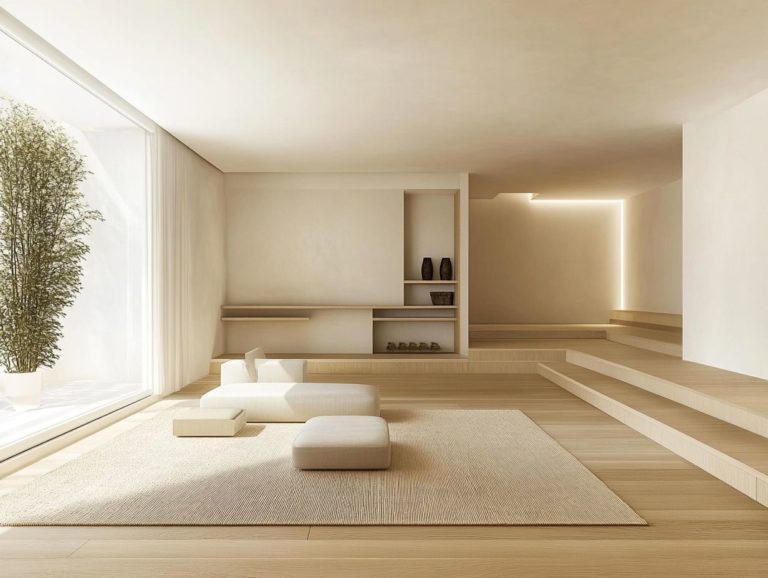Customizable Designs for Eco-Conscious Homeowners
In a world increasingly centered on sustainability, eco-conscious home design presents a refreshing approach to crafting living spaces that honor the environment while enhancing your quality of life.
This article delves into the numerous benefits of adopting an eco-friendly way of thinking in home design, from significant cost savings and reduced environmental impact to customizable features that cater to your unique climate and location.
Discover how you can transform your home into a sustainable sanctuary by incorporating renewable energy sources, selecting eco-friendly materials, and embracing innovative landscaping that resonates with your values and style.
Stay ahead of the curve by exploring the latest trends and future possibilities in eco-conscious design, inspiring you to make informed choices for a greener tomorrow.
Contents
- Key Takeaways:
- Benefits of Eco-Conscious Home Design
- Factors to Consider for Customizable Designs
- Designing for Energy Efficiency
- Creating a Sustainable Landscape
- Utilizing Native Plants and Rainwater Harvesting
- Eco-Conscious Home Design Trends
- The Future of Eco-Conscious Home Design
- Your Top Questions About Eco-Friendly Home Designs Answered!
- 1. What are customizable designs for eco-conscious homeowners?
- 2. How can customizable designs benefit eco-conscious homeowners?
- 3. Are customizable designs more expensive than traditional home designs?
- 4. Can I still have a unique and personalized home with customizable designs?
- 5. What are some common features of customizable designs for eco-conscious homeowners?
- 6. Can I make changes to a customizable design once it has been built?
Key Takeaways:
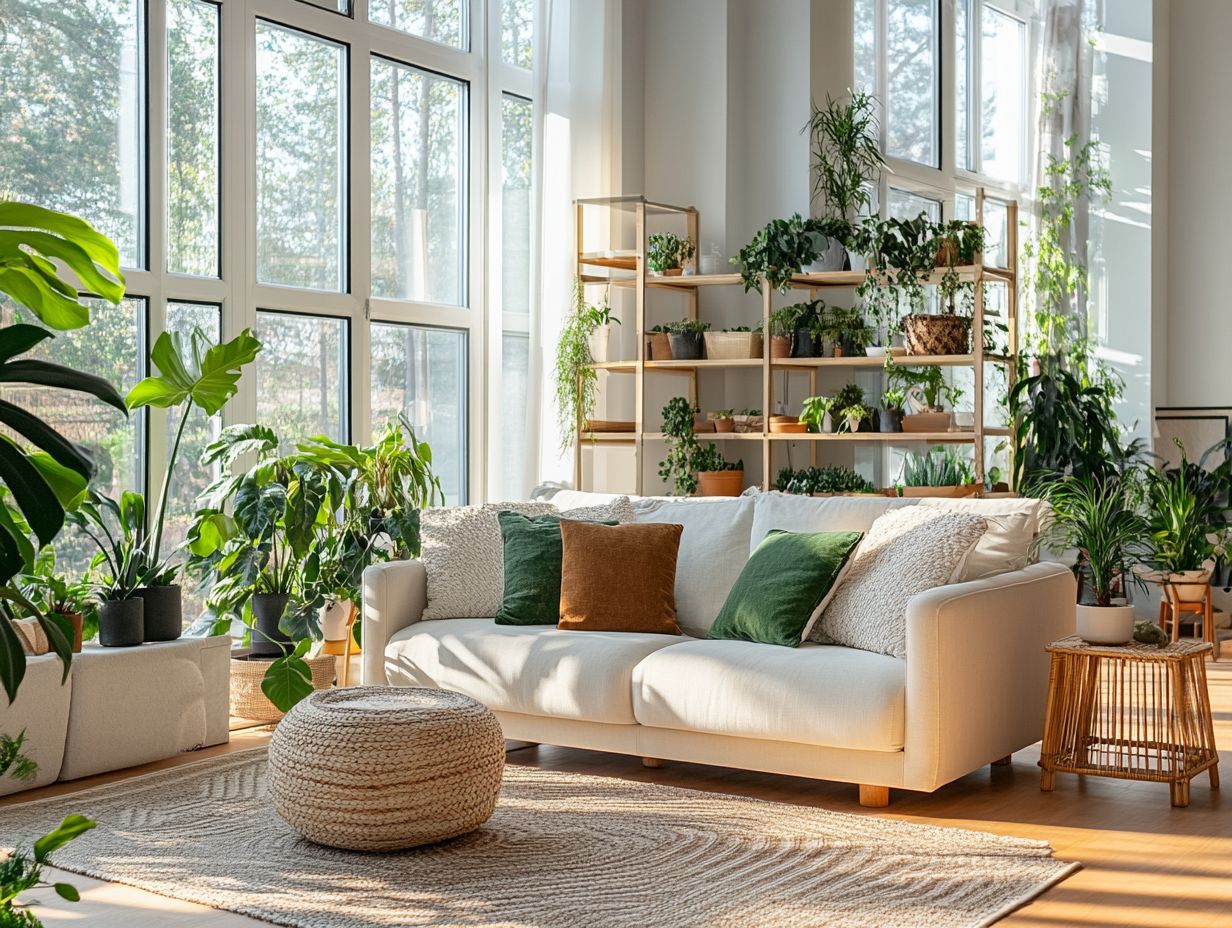
- Eco-conscious home design saves money and reduces environmental impact.
- Customize your home with materials and technologies suited to your location and climate.
- Enhance your space with natural lighting, renewable energy, and native plants.
What is Eco-Conscious Home Design?
Eco-Conscious Home Design prioritizes sustainability and integrates eco-friendly materials and technologies, including innovative customizable designs for urban living, ensuring your home has a positive environmental impact.
At the heart of eco-conscious design lies the commitment to minimizing waste and optimizing resource efficiency, a vital step in reducing your carbon footprint. By opting for renewable materials like bamboo or reclaimed wood, you enhance sustainability and promote healthier living spaces for you and your loved ones.
Incorporating technologies like solar panels and rainwater harvesting systems reduces reliance on non-renewable resources. By integrating these elements, you adopt a more responsible approach to homeownership while appealing to a growing demographic that values green living, ultimately paving the way for a more sustainable future.
Diving into the intricacies of eco-conscious building practices allows you to make informed choices that benefit both your household and the planet, creating a harmonious balance that resonates with your values.
Benefits of Eco-Conscious Home Design
The advantages of Eco-Conscious Home Design go far beyond mere aesthetics; they offer substantial cost savings and a minimized environmental footprint.
Incorporating energy-efficient appliances and sustainable practices like rainwater harvesting and low-water landscaping enables you to enjoy lower utility bills. Homes built with these principles often achieve LEED certification, a hallmark of environmental responsibility and sustainable living.
These designs elevate your personal comfort and play a significant role in contributing to broader ecological benefits.
Start your journey towards a sustainable home today! Together, we can build a better future for our planet.
Environmental Impact and Cost Savings
One of your primary considerations in Eco-Conscious Home Design should be the environmental impact, which closely ties to your potential cost savings. By opting for recycled materials and energy-efficient windows, you can significantly reduce waste and lower your energy consumption. This leads to long-term financial benefits.
This approach encourages the use of reclaimed materials and smart home technologies. Ultimately, you ll create spaces that not only look stunning but also function efficiently and sustainably.
Implementing solar panels can further decrease your reliance on non-renewable energy sources. This results in substantial savings on your utility bills. Water-efficient appliances, like low-flow faucets and dual-flush toilets, conserve water while also trimming down your monthly expenses.
Consider incorporating green roofs. They enhance insulation and manage stormwater, transforming ordinary homes into lifetime investments that positively impact the ecosystem.
By prioritizing these eco-friendly strategies, you re not just elevating your living space; you re also playing a vital role in fostering a more sustainable world while keeping your budget in check.
Factors to Consider for Customizable Designs
When you embark on an Eco-Conscious Home Design, it’s essential to consider several factors to achieve a result that is both customizable and sustainable.
The location is paramount. Climate considerations directly influence your choices regarding sustainable materials and design strategies, such as passive house design, which naturally maintains comfortable temperatures without relying on mechanical heating or cooling.
Gaining a deep understanding of the local environment will help you create a home that optimizes energy use and comfort, meeting your specific needs and desires as a homeowner.
Location and Climate Considerations
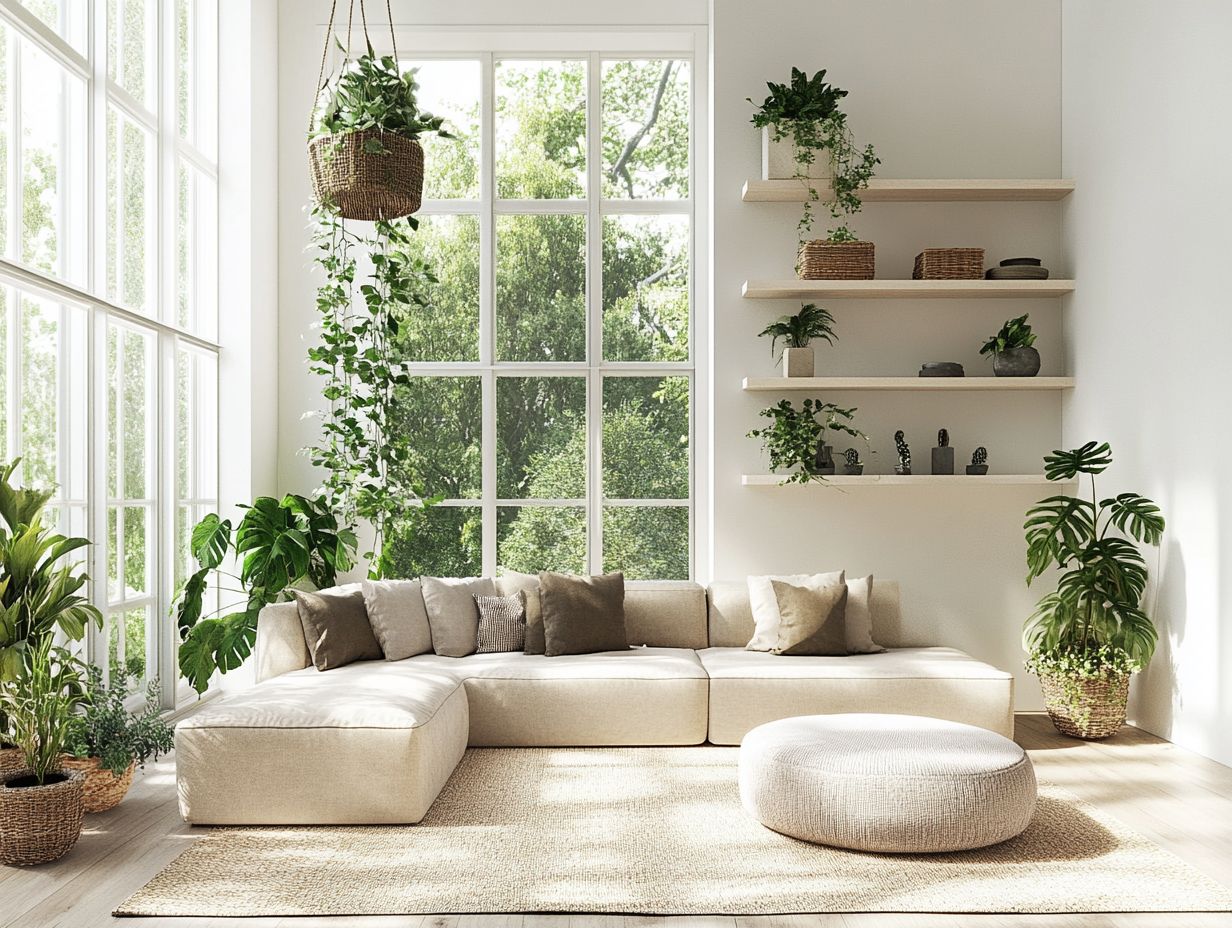
Location and climate considerations play a pivotal role in the design of eco-conscious homes. They determine the environmental strategies you can effectively implement. For instance, if you re in Arizona, you can harness solar power and utilize passive cooling techniques.
On the other hand, if your property is in Colorado, prioritizing natural insulation and energy-efficient windows will help you withstand harsh winters.
In the Florida Keys, adopting low-water landscaping and water conservation practices becomes crucial for addressing local environmental challenges.
These tailored strategies underscore the importance of understanding the unique characteristics of your region. In areas prone to heavy rainfall, for example, installing green roofs and rainwater harvesting systems can significantly mitigate runoff and foster sustainable living.
Meanwhile, coastal regions often require raised foundations to combat flooding, along with resilient building materials built to withstand saltwater exposure.
By leveraging local resources and adapting to climate conditions, these eco-conscious designs enhance energy efficiency and promote ecological stability. This allows communities to thrive in harmony with their environments.
Eco-Friendly Materials and Technologies
The choice of eco-friendly materials and technologies is essential for your success in eco-conscious home design. These decisions significantly impact both sustainability and aesthetic appeal. By incorporating recycled materials, Energy Star appliances, and smart home technologies, you can optimize energy efficiency and minimize your overall environmental footprint.
Selecting high-quality insulation and sustainable building practices ensures that your living spaces are not only functional but also environmentally responsible.
Consider options like bamboo flooring and reclaimed wood. They offer unique visual character while reducing the demand for new materials and promoting responsible forestry practices.
Utilizing solar panels can lead to substantial savings on energy bills while tapping into renewable resources. Water-saving fixtures and low-VOC paints help create a healthier living environment by reducing pollutants.
These choices not only demonstrate your commitment to eco-friendliness but also enhance your property’s value. They are appealing options for anyone dedicated to creating a sustainable oasis.
Start your journey toward an eco-friendly home today! Explore more eco-friendly options to make your home not just beautiful, but sustainable!
Designing for Energy Efficiency
Designing for energy efficiency is a fundamental principle of eco-conscious home design. It emphasizes strategies that significantly lower energy consumption while harnessing renewable resources.
By integrating elements like solar power systems, energy-efficient windows, and superior insulation, you can create homes that operate on far less energy.
Employing techniques such as passive house design which focuses on minimizing energy use by leveraging natural surroundings can further elevate a home s efficiency, optimizing natural ventilation and reducing dependence on mechanical heating and cooling.
Incorporating Renewable Energy Sources
Incorporating renewable energy sources is essential for your eco-conscious home design, allowing you to significantly lower reliance on fossil fuels. Solar power systems can serve as a primary renewable energy source, complemented by technologies like wind energy to meet your energy needs.
By integrating energy-efficient appliances, you can maximize the advantages of these renewable sources, leading to reduced energy bills and a smaller carbon footprint.
Consider options such as geothermal heating and biogas systems, which are reliable alternatives contributing to sustainability. While the initial investment may seem daunting, the long-term savings and environmental benefits usually far outweigh the upfront costs.
Don’t overlook potential challenges, like site-specific limitations for wind turbines or solar panel placements. With thoughtful planning, you can ensure these renewable sources harmoniously coexist within your home.
When paired with smart appliances and energy management systems, they create a cohesive strategy for energy consumption, enabling you to reduce waste, enhance efficiency, and embrace a greener lifestyle.
Maximizing Natural Light and Airflow
Maximizing natural light and airflow is crucial for creating energy-efficient homes that prioritize comfort and minimize energy consumption. Techniques such as precise window placement, energy-efficient windows, and open floor plans significantly enhance the flow of natural light and ventilation.
This captures the essence of passive house design, which focuses on energy efficiency. Not only does this approach reduce reliance on artificial lighting and climate control, but it also cultivates a healthier living environment.
To truly reap these benefits, consider incorporating skylights and larger glass doors. These features illuminate your spaces while seamlessly connecting the interior to the outdoors. Strategic landscaping is another key element; for example, planting trees at a distance from your windows can modify light exposure without obstructing natural breezes.
Many contemporary residential designs also employ cross-ventilation techniques, allowing fresh air to circulate freely through multiple openings.
By prioritizing these design principles, you can enjoy spaces that are not only aesthetically pleasing but also environmentally responsible, showcasing your commitment to sustainable living.
Creating a Sustainable Landscape
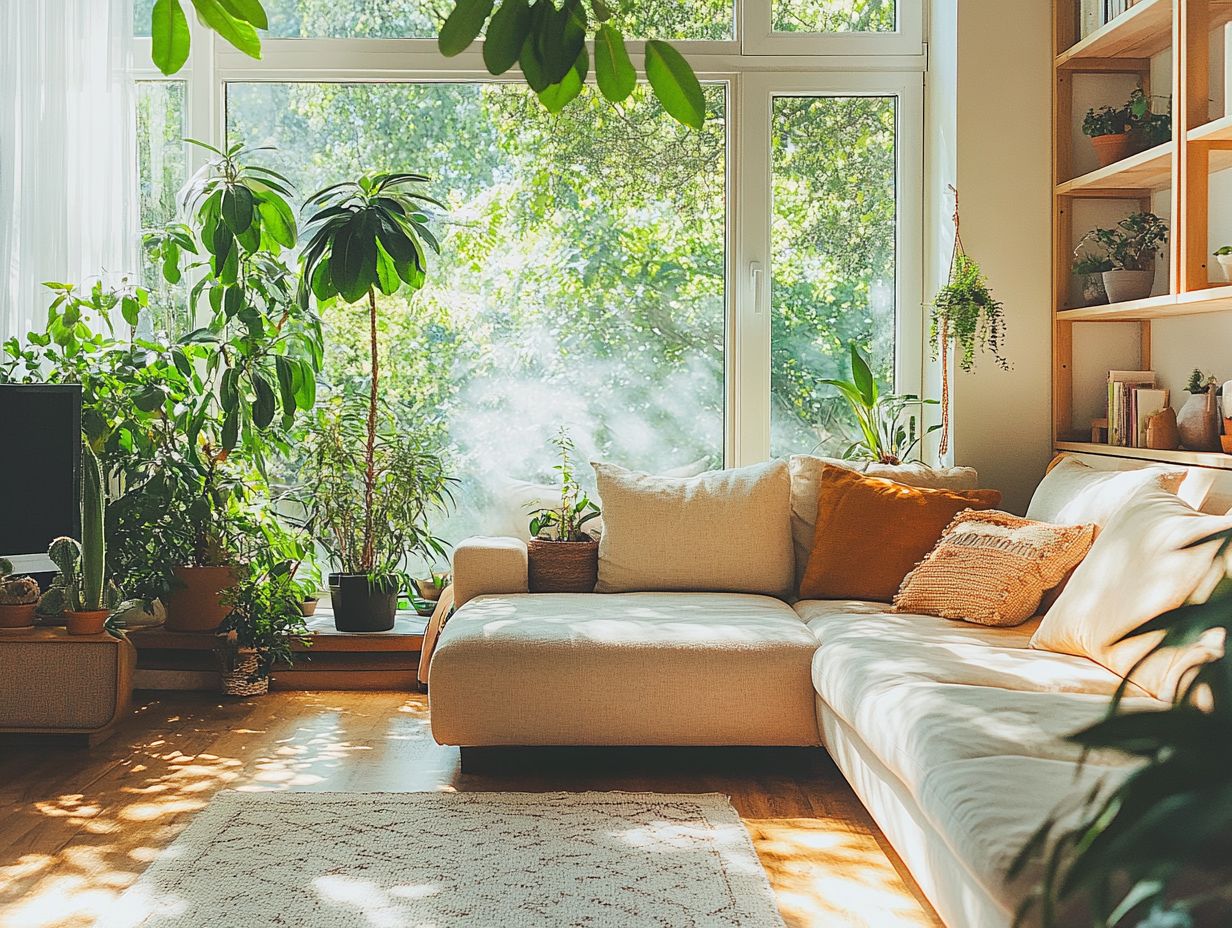
Creating a sustainable landscape is essential for eco-conscious home design, enhancing both aesthetic appeal and environmental well-being.
By embracing native plants and employing low-water landscaping techniques, you can cultivate gardens that flourish in your local climate while conserving valuable water resources.
Integrating practices like rainwater harvesting enables effective water management, creating a lush outdoor oasis that is both beautiful and eco-friendly.
Utilizing Native Plants and Rainwater Harvesting
Using native plants and rainwater harvesting are exceptional strategies for creating a sustainable landscape that requires minimal maintenance while promoting water conservation.
Native plants are well-suited to your local environment, making them resilient and efficient in their water usage.
By incorporating rainwater harvesting systems, you can collect and use natural rainfall to irrigate your garden. This approach enhances sustainability and reduces your environmental footprint.
This innovative strategy reduces your reliance on municipal water sources and significantly lowers your water bills. Native plants also attract local pollinators and wildlife, fostering biodiversity in your garden.
If you re considering these strategies, start with a thoughtful garden plan that emphasizes native flora. Research plants that thrive in your region and consider adding a rain barrel or a cistern to efficiently gather and store rainwater.
Applying mulch and implementing drought-resistant techniques can further reduce the need for irrigation. This helps cultivate a lush landscape while conserving valuable resources.
Eco-Conscious Home Design Trends
Eco-conscious home design trends are constantly evolving, reflecting the growing awareness of sustainability in contemporary architecture. You’ll find innovative customizable designs for a modern farmhouse in esteemed publications like Architectural Digest and House Beautiful, where builders integrate eco-friendly materials, designs that use natural energy, and smart home technologies into their projects.
These trends enhance the aesthetic appeal of spaces and foster a commitment to sustainable living, allowing you to create a home that aligns with your values and style.
Innovative and Stylish Designs
Innovative and stylish designs lead the charge in eco-conscious home design, proving that sustainability can indeed be beautiful. The role of customizable designs in modern homes showcases how eco-conscious builders are increasingly turning to innovative materials that combine functionality and aesthetics, similar to what you would find in esteemed publications.
These designs often embrace open spaces, abundant natural light, and energy-efficient technologies, creating homes that are stunning and sustainable.
Architects are incorporating elements such as green roofs, which provide insulation while fostering urban biodiversity. Take the Bosco Verticale in Milan, for example this project showcases vertical gardens that elevate the building’s visual appeal and enhance air quality.
Homes crafted from reclaimed materials reflect a dedication to style and sustainability, offering unique characteristics that resonate with environmentally-conscious buyers. For those looking to enhance their space, exploring the best customizable design platforms for homeowners can provide valuable options.
Furthermore, innovations in passive solar design allow homes to harness natural light and regulate temperature effectively, achieving a balance between modern living and ecological responsibility.
The Future of Eco-Conscious Home Design
The future of eco-conscious home design is set to welcome more advanced technologies and sustainable practices, including the best customizable design tools for homeowners, showcasing your commitment to environmental stewardship.
As smart home technologies become more accessible, you will likely integrate these innovations to enhance both efficiency and comfort. Expect to see a rise in sustainable materials and designs that emphasize harmony with nature and community well-being.
Emerging technologies like solar panels and energy-efficient appliances will soon be standard features in homes, significantly reducing your carbon footprint.
Innovative building materials, including recycled and bio-based options, will support sustainability while adding a unique aesthetic appeal to your living space.
Embracing biophilic design principles encourages the creation of indoor-outdoor living environments, deepening your connection with nature. With advancements in home automation, you ll monitor energy usage in real-time, fostering conscious consumption.
Ultimately, these trends will transform your residence into an eco-friendly sanctuary that prioritizes comfort and ecological responsibility.
This video explores the latest in eco-conscious home design and practical tips for your own home.
Your Top Questions About Eco-Friendly Home Designs Answered!
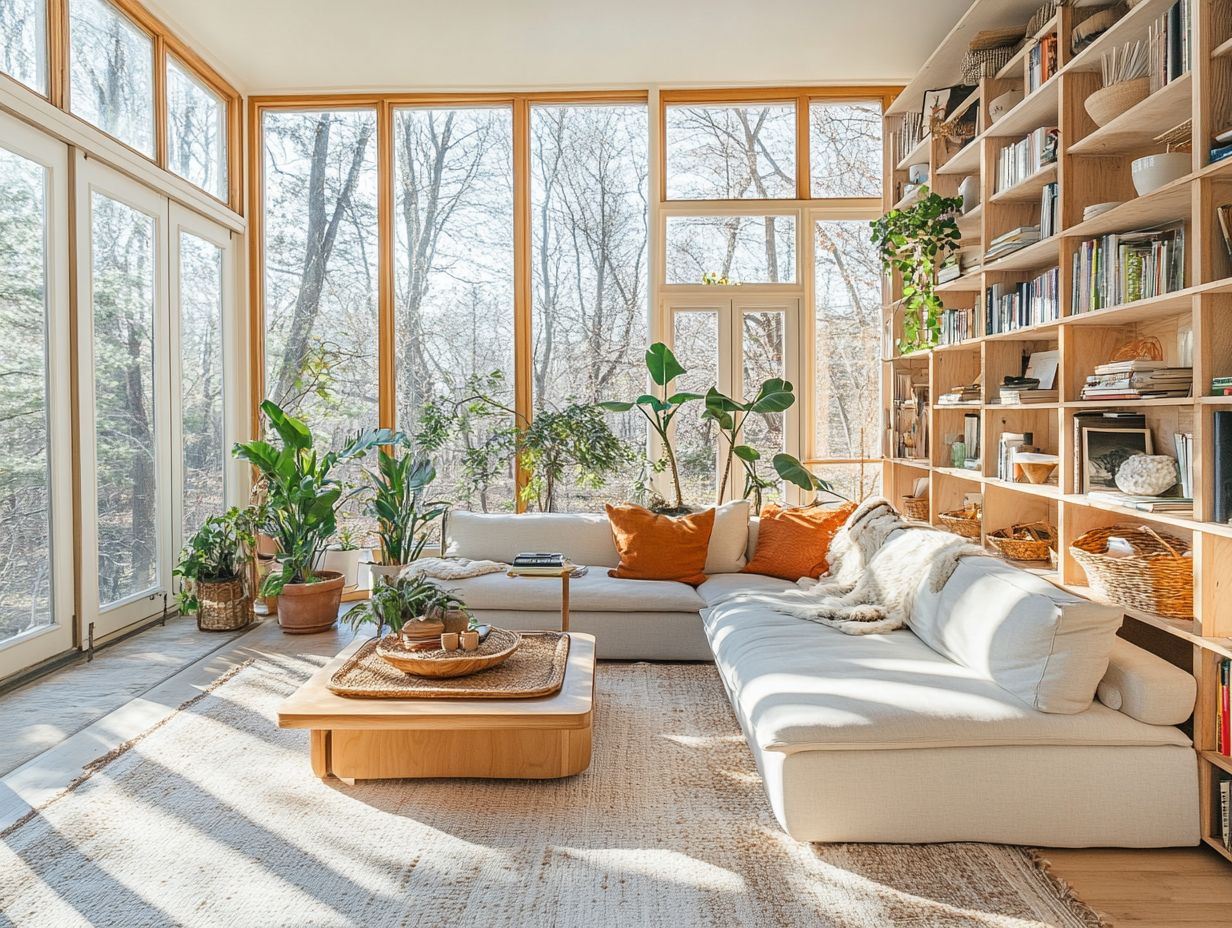
1. What are customizable designs for eco-conscious homeowners?
Customizable designs are tailored to homeowners who care about being eco-friendly and living sustainably, such as eco-friendly customizable designs for sustainable living. They focus on meeting specific needs and preferences.
2. How can customizable designs benefit eco-conscious homeowners?
These designs reduce carbon footprints and boost energy efficiency. They also create healthier living spaces.
3. Are customizable designs more expensive than traditional home designs?
Not always! While some options may be pricier, many affordable choices offer great eco-friendly features.
4. Can I still have a unique and personalized home with customizable designs?
Absolutely! Customizable designs for a minimalist home let you add your personal touch. You can make your home unique while incorporating eco-friendly elements.
5. What are some common features of customizable designs for eco-conscious homeowners?
Common features include energy-efficient appliances, sustainable materials, natural lighting, and smart home tech. Discover these must-haves today!
6. Can I make changes to a customizable design once it has been built?
Yes! Many customizable designs allow for changes and additions after the home is built. This flexibility lets you keep making eco-friendly updates over time.





